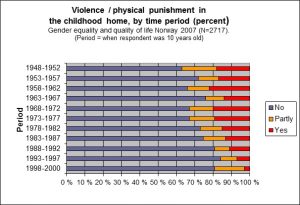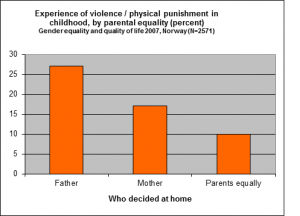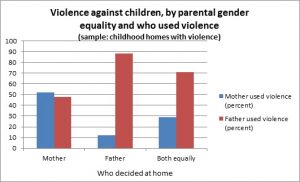For many years now, we have heard how men do this and women do that.
Men and women are different.
For example, men are more violent than women.
Only recently has research introduced gender in/equality as a control variable, regarding these proclaimed gender differences.
The results are dramatic.
Introducing the gender equality variable unsettles much of what we think we know about gender.
For example:
In the 2007 “Gender equality and quality of life” survey (in Norway), almost 2800 respondents answered questions about their childhood home. During the time of their childhood reports, the rate of violence against children generally became lower.
 Across this period, gender equality, more than gender, influenced the chance of violence against children. “Who decided at home” (wh0 had the final say) was used as indicator of gender equality.
Across this period, gender equality, more than gender, influenced the chance of violence against children. “Who decided at home” (wh0 had the final say) was used as indicator of gender equality.
Gender inequality, even more than gender, influenced the chance of violence against children.
Father-dominated homes had almost three times the rate of violence against children, compared to gender-equal homes, in the 1940-2000 period covered by the study. Women-dominated homes were in the middle. Gender-equal homes, where the parents decided equally, had the lowest rate of violence.
Those who decided at home were also the ones most likely to use violence.
Generally, men were more often involved in the use of violence and physical punishment of children, but this varied strongly with the state of gender equality in the home. In mother-led homes, women were slightly more involved than men.
The impact of gender equality remained strong, controlling for education and other social factors.
In most of today’s research, gender equality is not used as a variable – the evidence is at best divided by gender, or it is just presented as gender-neutral.
The above example shows the need to correct that situation. By neglecting gender in/equality, research is missing the true picture.
Recently, a Poland survey has confirmed the basic pattern found in the Norway 2007 survey.
In Poland, also, lack of gender equality among the parents approximately doubles the chance of violence against children. Even if Norway and Poland are different in many respects, including different views of gender, these basic results are much the same.
Violence against children is just one area where gender equality has an impact.
Other areas, more focused in recent research, include education, health, quality of life, social perception and social stigma.



